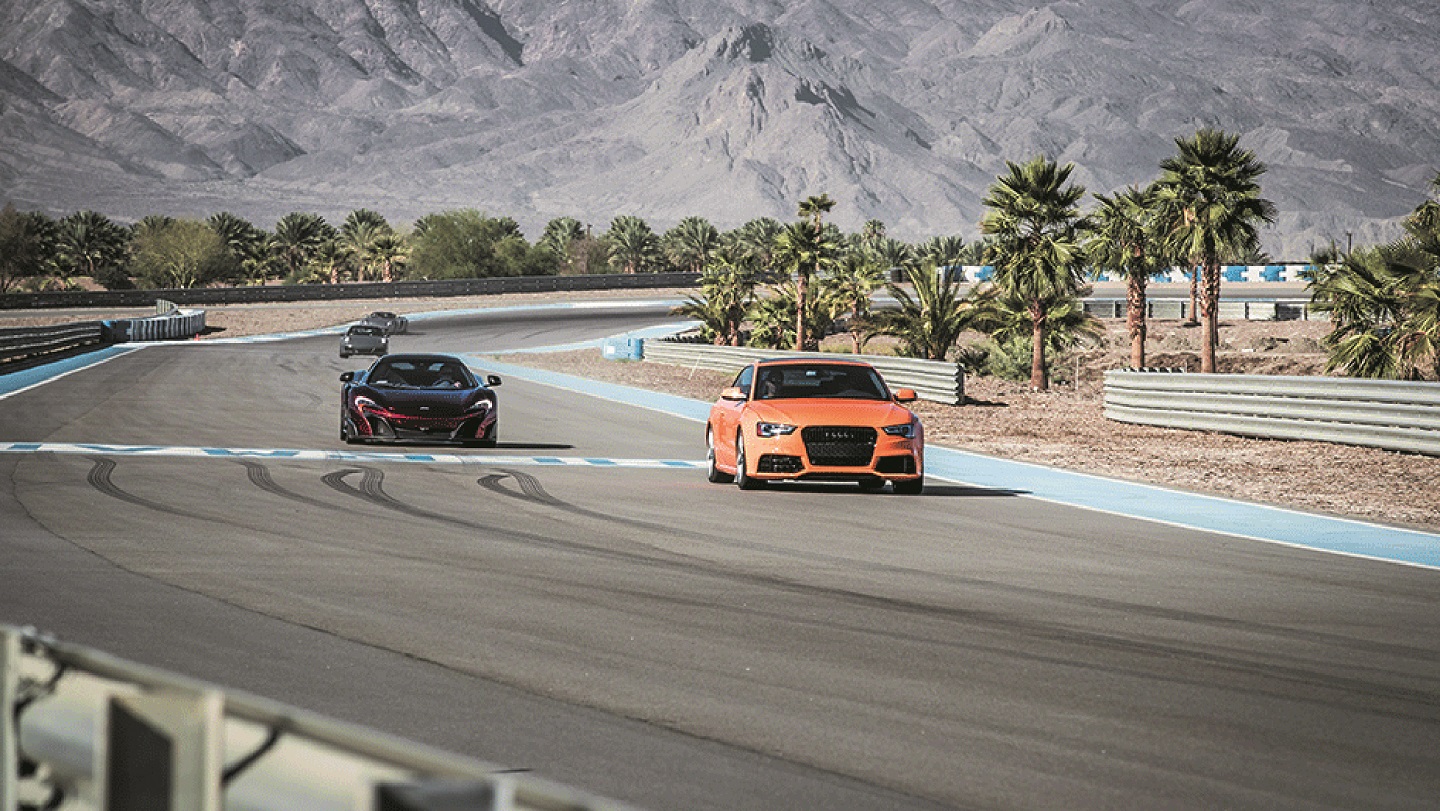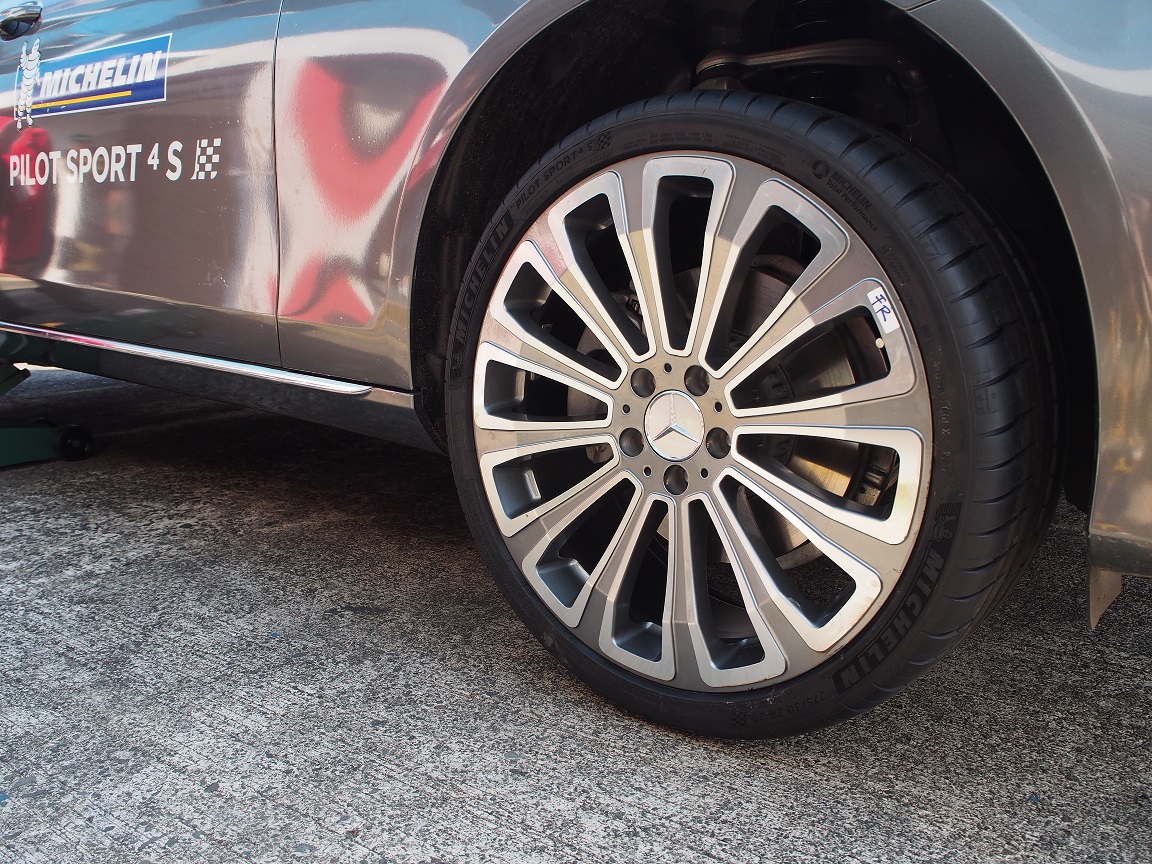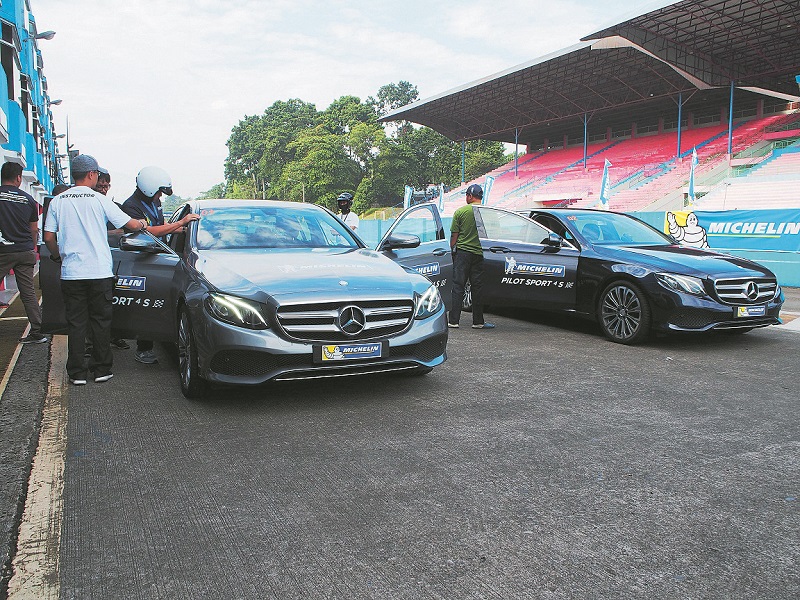
We arrived at the Sentul International Circuit, in the hilly region of Bogor, Indonesia, and walked into the marquee where a gleaming white Mercedes Benz E300 was parked. On any given day, the fine-looking car would be the star of the show, but on this day, it played the role of accessory.
The actual star of the day, the Michelin Pilot Sport 4 S (PS4S) tyre, was understatedly displayed on the right side of the tent, only drawing attention when Bibendum, the iconic Michelin Man, bounced over for a photo op.
Like a pair of good shoes that can make all the difference to a runner, the performance of the best cars is only brought out through a good set of tyres — where the tiny patch of rubber is the vehicle’s only contact with the ground.
Yet, it is the part of the car often taken for granted, especially if one has to choose between paying for a set of better tyres or upgrading other components.
On that note, the question we set out to explore in Sentul — at the invitation of Michelin — was whether the PS4S makes enough of a difference in the driving experience for the average city-driving folk.
The tyre
Launched earlier this year, the French tyre manufacturer’s latest ultra-high performance (UHP) model is designed for sports cars, premium sedans and other high-performance vehicles, replacing the popular Pilot Super Sport (PSS) and the Pilot Sport 2, which are being phased out. In the manufacturer’s hierarchy, the new tyre sits above Pilot Sport 4 (PS4), which was launched last year, and is positioned as a bridge between that and the more track-focused Pilot Sport Cup 2 (PSC2).
Considering that the six-year-old PSS had set the standard as leader of its class, Michelin’s confidence in the PS4S as a worthy successor is not misplaced, judging from reviews and test records. Technology and performance-wise, it has been declared by Michelin to be better in every aspect than the PSS, thanks to the new bi-compound material used. According to compound designer Laurent Huc, the recipe was painstakingly derived after working with 3,000 different compounds during the development of the PS4S. Only two made it into the final product, which is targeted to put Michelin further ahead of competitors, especially its dominance of wet weather performance.

The key evolution of the technology is the construction of the tyre. Building on the former PSS, Michelin uses
“Dynamic Response” technology, which was introduced in the PS4 series.
It benefits from a manufacturing process similar to that used in creating motorsport tyres, using a hybrid belt of aramid and nylon to construct better patch stability at high speeds and better withstanding of centrifugal forces.
The PS4S features one compound on the outer edge of the tyre and another on the inner section to cover a wider variety of driving conditions and improve wear resistance. The outer portion is made up of a harder carbon black elastomer material for dry grip, which reduces stress on the contact patch and dissipates heat, coming into play especially during heavy braking or difficult cornering. The softer silica-infused inner shoulder provides excellent grip for normal driving and wet conditions. A differently angled tread groove enhances the longevity of the tyre.
But the biggest surprise of the PS4S is its pricing. In Malaysia, prices start at RM1,100 per tyre, with sizing for rims from 19 inches onwards and individualised fittings for different car types. Intriguingly lower than some of its other series and similar products by competitors, it belies the general rule of thumb that the more expensive a tyre the better it is. All Michelin says when queried is that it is a conscious move to price it affordably.
The drive
Nevertheless, the PS4S is not your average tyre, with the premium price tag to match. On that note, this average city driver hit the track in Sentul with the aim of finding out what driving with a UHP tyre would be like. To ensure the best potential performance at the wheel, two Mercedes Benz E250s awaited us at the pit — one fitted with the PS4S and another with the Pirelli P90 tyre, another UHP tyre with a good reputation.
Rather than a road test or track driving, Michelin designed a test course involving a number of challenges, including high-speed tight corners, a zig-zag section and an acceleration to hard braking test.
Taking the Pirelli P90 car first — there was a short drive before arriving at the first test in the 4.12km long, rather badly maintained circuit. It brought to mind the conditions of some of our roads here.
In the PS4S car, a certain stickiness was immediately felt, a feeling of heaviness in their traction that took some getting used to at first. But when we arrived at the turns and zig-zag, the “stickiness” made all the difference. At speeds of 55 to 75kph, the Pirelli felt a tad slower to respond, and after driving the Michelin, the comparative lack in weightiness was palpable, albeit less obvious on normal crusing.

Of course, with premium tyres like the two we tested, differences felt would be slight. Nonetheless, when the speed is doubled or tripled, what was slight would become a crucial margin.
The PS4S is touted for its steering precision and dynamic stability. When tested, this translates into a handling that almost felt like it had a life of its own, a credit to the dynamic response technology. As I took the last zig-zag turn at 63kph, my test coach and designer of the test, pro-race instructor Kenneth Chew said breezily, “no drama”.
That was an apt description of the little effort it took for the tyres to respond. In fact, my speed was slightly too slow to feel the full effect of its steady comfort. As a passenger later on in the more powerful Mercedes Benz AMG C43 Coupe, a speed of 70 to 80kph at the zig-zag yielded only mild movement, something that impressed this car-sick prone person. Comparatively, the competitor’s tyre noticeably understeered and stepped out slightly.
During the dry braking test, the Michelin recorded a stop distance of 22.6m (the average distance of all test drivers that day was 22m), whereas the Pirelli recorded 23.3m (the average was 23.7m).
It was during the wet test that the superiority of the Michelin PS4S’ grip shone when cornering, only slightly understeering compared with the dry test. The wet brake test saw the Pirelli stop at a distance of 28m. Unfortunately, the Michelin failed to record the distance during this test, though the stop distance was close to a metre shorter than the other car. The recorded average of the day was 29.1m for the competitor’s tyre and 28m for the PS4S.
From our experience, Michelin’s claim that the PS4S series is “best in its class” is justifiable, be it in steering, balance, reactivity and grip. The next question to ask is, can it be too much of a good thing? A UHP tyre has race-like attributes, so, unless you’re lapping around the track or fancy yourself a weekend speed demon along our highways, you would not realise its full potential. The tyre’s advanced technology is such that the average driver would not bring out its maximum performance in a normal drive, even in a premium car.
That was something to grapple with as we left the track and made our way back up the winding roads to the Royal Tulip Gunung Geulis Resort. When it comes to tyres, most people just want maximum mileage, good safety and comfort support. But when all that can set standards, and come with prestige, a 30,000-mile warranty and, perhaps, bragging rights, why not?
The Michelin Pilot Sport 4 S Is now available in Malaysia and distributed by Tyreplus and Michelin outlets nationwide.


